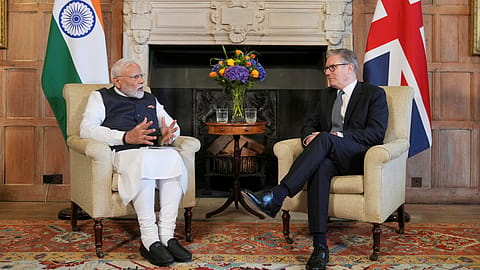India-U.K. CETA: What the government procurement chapter means for Indian businesses
The Government Procurement (GP) chapter opens up significant opportunities for Indian suppliers to access the U.K.’s public procurement market, which is valued at over £90 billion annually.

The recently signed comprehensive economic and trade agreement (CETA) between India and the United Kingdom marks a significant milestone in bilateral trade relations. One of the key components of this agreement is the Government Procurement (GP) chapter, which opens up new opportunities for Indian suppliers to access the U.K.’s public procurement market, estimated at over £90 billion annually. At the same time, India has carefully structured its commitments to safeguard sensitive sectors and protect its domestic industries and MSMEs.
The Ministry of Commerce and Industry, led by Union Minister Piyush Goyal, has issued FAQs (frequently asked questions) on what has been offered, what India gains, and how key safeguards have been built into the agreement to ensure balanced and inclusive benefits.
Here are the FAQs on the India-U.K. CETA government procurement chapter:
What has been offered to U.K. suppliers in the India–U.K. CETA GP chapter?
India has offered central-level procurement (including CPSEs) to U.K. suppliers. India’s market access schedule (Annex 15A) lists 51 central government entities and an indicative list of 28 CPSEs.
What is included in the U.K.’s market access offer?
The U.K.’s market access schedule (Annex 15B) lists 48 central government entities as well as an indicative list of utility-level entities. The U.K. has also included entities such as Belfast Metropolitan College, Northern Regional College, and North West Regional College, which have not been offered to all trading partners. Additionally, the U.K. schedule lists services offered to Indian suppliers.
Recommended Stories
What are the benefits available to Indian suppliers?
As part of the FTA, Indian suppliers have guaranteed access to U.K. procurements conducted at the central level of government and to certain utilities.
In 2022, the value of such opportunities was approximately £90 billion ($120 billion) [Source: Internal calculation based on U.K. notification to the WTO Committee on Government Procurement dated 19 March 2025].
Suppliers will be able to participate in procurements by major government entities such as the Cabinet Office; Department for Business and Trade; National Highways; Department of Health and Social Care; Foreign, Commonwealth and Development Office; and Department for Education, among others. In addition, Indian suppliers can participate in procurements by entities such as Belfast Metropolitan College, Northern Regional College, and North West Regional College, which are not offered to all trading partners.
The Government Procurement chapter will ensure meaningful market access for Indian-based suppliers. Indian suppliers will be able to compete in U.K. procurements across a wide range of goods, services, and construction services. These include construction, IT, financial and insurance services, telecommunications, architectural services, and other business services that may be of interest to Indian firms.
How has India protected its sensitive sectors?
India’s offer includes only non-sensitive procurement at the central level.
It excludes sensitive ministries/departments such as the Ministry of Defence, Ministry of Home Affairs, Ministry of Electronics and Information Technology, Department of Personnel and Training, and Department of Space.
India has not offered state or local government-level access to U.K. suppliers.
How is the U.K. procurement market more accessible?
Indian suppliers will not only be granted non-discriminatory treatment in the U.K. procurement market, but they will also be treated on par with U.K. suppliers in terms of social value considerations during the procurement process. This ensures a level playing field for Indian businesses to compete fairly.
What safeguards has India put in place to protect Indian businesses and MSMEs?
Preserving policy space: India has secured a complete carve-out for its MSME preferential procurement policy. Under the Make in India policy, UK suppliers are eligible only as 'Class-II local suppliers' in domestic tenders above agreed thresholds. Indian suppliers will continue to receive preferential treatment as 'Class-I local suppliers'.
Asymmetric thresholds to allow expanded opportunities: The UK has accepted asymmetric thresholds in favour of India. The UK's thresholds for goods and services are at the WTO GPA level of SDR 130,000 (approx. ₹1.6 crore), while India has a higher threshold of SDR 450,000 (approx. ₹5.5 crore). For construction services, both parties have agreed to a threshold of SDR 5 million (approx. ₹62 crore).
The special drawing right (SDR) is an international reserve asset created by the International Monetary Fund (IMF). While it is not a currency, its value is determined based on a basket of five major international currencies: the U.S. dollar, the euro, the Chinese renminbi, the Japanese yen, and the British pound sterling.
Facilitating measures for Indian small businesses: The chapter includes an article aimed at facilitating the participation of small businesses in procurement. These provisions include free tender documents and prompt payments to suppliers, among others.
Safeguards to protect country of origin concerns: The eligibility for U.K. suppliers to participate as 'Class-II local suppliers' is subject to a country of origin requirement. Only U.K. suppliers offering goods or services with the U.K. as their country of origin are eligible for such treatment.
Will Indian suppliers have access to legal recourse in case of any concerns with the U.K. procurement process?
Yes, Indian suppliers will have access to domestic review mechanisms within the U.K., enabling them to formally challenge any unfair practices or decisions made by U.K. procuring entities during the procurement process.